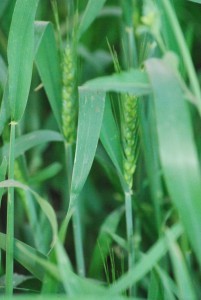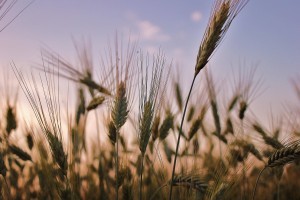 In Matthew 13:24-30 we read about the parable of the wheat and the tares. Tares are weeds but not just any random weed. It is a weed that resembles wheat except that its grains are black and inedible. In the parable, Jesus is teaching about a man who has planted good seed in his field. He was looking for a good crop of wheat and wasn’t intending to have tares in his field. When Christ established His church He did not intend to have other “churches” spring up (Matthew 7:21-23), although He knew it would happen. He knew false teachers would spring up (Matthew 7:15-20). He knew other baptisms would be taught (Ephesians 4:4-6). He knew others would believe there could be more than one way to heaven (Matthew 7:13-14). He knew people would want to do what was right in their own eyes (Judges 17:6). Yet He planted anyways.
In Matthew 13:24-30 we read about the parable of the wheat and the tares. Tares are weeds but not just any random weed. It is a weed that resembles wheat except that its grains are black and inedible. In the parable, Jesus is teaching about a man who has planted good seed in his field. He was looking for a good crop of wheat and wasn’t intending to have tares in his field. When Christ established His church He did not intend to have other “churches” spring up (Matthew 7:21-23), although He knew it would happen. He knew false teachers would spring up (Matthew 7:15-20). He knew other baptisms would be taught (Ephesians 4:4-6). He knew others would believe there could be more than one way to heaven (Matthew 7:13-14). He knew people would want to do what was right in their own eyes (Judges 17:6). Yet He planted anyways.
The tares in this parable were planted by the enemy. Who is our greatest enemy? Yeah, it’s Satan. He is constantly trying to choke out those who are constantly trying to be a good crop of faithful Christians. The best way for him to accomplish this choking is to bring in the weeds that look almost like the real thing. There are lots of good, well-meaning people in this world that look just like you and me. But one thing is lacking in their lives. Their grains are black and stained with sin (Acts 22:16). They haven’t completely given themselves over to Christ.
The servants had a great idea. Let’s get rid of the bad so the good can grow, but how can you get rid of something that is so intertwined with the good and not harm the good? How are we to judge the hearts of men? We can’t. That is only something God can do (Luke 16:15).
So the wheat and the tares, the faithful and the sinner must live together, but not for eternity. At the end of this parable, in verse 30, is where the separation comes. The tares, “all things that offend, and them which do iniquity” (Matthew 13:41) will be weeded out and thrown “into a furnace of fire: there shall be wailing and gnashing of teeth” (Matthew 13:42). The wheat, the righteous, will “shine forth as the sun in the kingdom of their Father” (Matthew 13:43).
 As long as this earth stands, the wheat and the tares must live together in this world. One of the unique things about this parable is that the tare doesn’t have to remain a tare. The tare can become wheat; the sinner can become righteous (Romans 10:17; John 8:42; Luke 13:3; Acts 8:37; Acts 2:38; Revelation 2:10). But that wheat can become a tare if it is not careful. In 1 Corinthians 15:33 we are warned that evil company corrupts good habits. The righteous can go back to being a sinner because hanging with the tares can rub off onto the good. The lesson we can learn from this parable is to be the best, strongest, heartiest stalk of wheat we can be to withstand the temptations of the tares. And while we are trying to be 100% whole wheat, we try to turn tares into wheat along the way so they too may one day shine as the sun.
As long as this earth stands, the wheat and the tares must live together in this world. One of the unique things about this parable is that the tare doesn’t have to remain a tare. The tare can become wheat; the sinner can become righteous (Romans 10:17; John 8:42; Luke 13:3; Acts 8:37; Acts 2:38; Revelation 2:10). But that wheat can become a tare if it is not careful. In 1 Corinthians 15:33 we are warned that evil company corrupts good habits. The righteous can go back to being a sinner because hanging with the tares can rub off onto the good. The lesson we can learn from this parable is to be the best, strongest, heartiest stalk of wheat we can be to withstand the temptations of the tares. And while we are trying to be 100% whole wheat, we try to turn tares into wheat along the way so they too may one day shine as the sun.
By Kristina Odom
Kristina and her husband, Justin, serve with the church of Christ in Fairfield, IL where her husband is the preacher. Kristina is a stay-at-home mother to their three kids.
 Welcome! We are so glad you stopped by. Come Fill Your Cup is a group of Christian ladies dedicated to equipping women for study and service. We know you are busy and that life’s hectic pace pulls you in so many directions, but you can’t truly be the woman God desires unless you take time to fill your own cup…not with spa days (though we love a good spa!) or the latest novel…but with God’s Holy Word. We want to help you with that! Our goal is to reach you in the midst of your busy day and give you encouragement, education, and fellowship as you strive to live the life God has laid before you. Our prayer is that we can help fill your cup so that you, in turn, can overflow to all those around you. So, as we like to say…come fill your cup, and let it overflow!
Welcome! We are so glad you stopped by. Come Fill Your Cup is a group of Christian ladies dedicated to equipping women for study and service. We know you are busy and that life’s hectic pace pulls you in so many directions, but you can’t truly be the woman God desires unless you take time to fill your own cup…not with spa days (though we love a good spa!) or the latest novel…but with God’s Holy Word. We want to help you with that! Our goal is to reach you in the midst of your busy day and give you encouragement, education, and fellowship as you strive to live the life God has laid before you. Our prayer is that we can help fill your cup so that you, in turn, can overflow to all those around you. So, as we like to say…come fill your cup, and let it overflow!
Thank you! This is a very nice study- one I needed to be reminded of.
We need the strength of our Savior to be that 100% wheat. It just isn’t in us naturally. I really enjoyed this article. Thank you! A good subject to keep before me all this week, all my life so that I can make it a priority to work on the tares.
Thanks again for a great “morning devo” with my cup of coffee literally and spiritually!